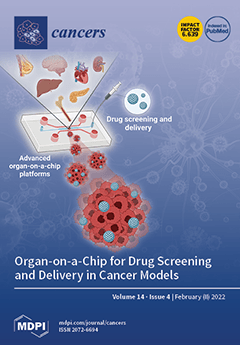The combination of Resminostat (HDACi) and Ruxolitinib (JAKi) exerted cytotoxic effects and inhibited proliferation of CTCL cell lines (MyLa, SeAx) in previously published work. A xenograft tumor formation was produced by implanting the MyLa or SeAx cells on top of the chick embryo
[...] Read more.
The combination of Resminostat (HDACi) and Ruxolitinib (JAKi) exerted cytotoxic effects and inhibited proliferation of CTCL cell lines (MyLa, SeAx) in previously published work. A xenograft tumor formation was produced by implanting the MyLa or SeAx cells on top of the chick embryo chorioallantoic membrane (CAM). The CAM assay protocol was developed to monitor the metastatic properties of CTCL cells and the effects of Resminostat and/or Ruxolitinib in vivo. In the spontaneous CAM assays, Resminostat and Ruxolitinib treatment inhibited the cell proliferation (
p < 0.001) of MyLa and SeAx, and induced cell apoptosis (
p < 0.005,
p < 0.001, respectively). Although monotherapies reduced the size of primary tumors in the metastasis CAM assay, the drug combination exhibited a significant inhibition of primary tumor size (
p < 0.0001). Furthermore, the combined treatment inhibited the intravasation of MyLa (
p < 0.005) and SeAx cells (
p < 0.0001) in the organs, as well as their extravasation to the liver (
p < 0.0001) and lung (
p < 0.0001). The drug combination also exerted a stronger inhibitory effect in migration (
p < 0.0001) rather in invasion (
p < 0.005) of both MyLa and SeAx cells. It further reduced p-p38, p-ERK, p-AKT, and p-STAT in MyLa cells, while it decreased p-ERK and p-STAT in SeAx cells in CAM tumors. Our data demonstrated that the CAM assay could be employed as a preclinical in vivo model in CTCL for pharmacological testing. In agreement with previous in vitro data, the combination of Resminostat and Ruxolitinib was shown to exert antitumor effects in CTCL in vivo.
Full article






